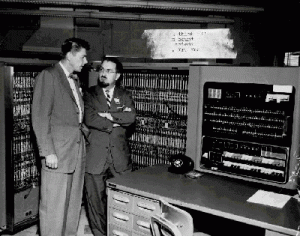There are numerous classifications of computers. Depending on the definition of a computer, it could date back all the way to 1822. There has been immense advancement in the evolution of computers. However, the first commercial computer which received widespread public attention began in the 1950’s.
- 1946→ ENIAC: first electronic general-purpose computer
- Able to solve a large class of numerical problems through reprogramming
- Designed for the specific purpose of computing values for artillery range tables
- Built during WWII
- Calculations for the construction of H-bomb
- John von Neumann → made important contribution
- Stored program computer → programs could be stored in memory (where the instructions and data also were)
- Von Neumann architecture
- Proposed idea of using ENIAC for the H-bomb
- 1950 → first computer with program stored in memory
- First delivered to the US government in 1950
- Called: UNIVAC 1101 or ERA 1101
- Considered first computer capable of storing and running a program from memory
- Mainly used by utilities, insurance companies and US military
- 1953 → IBM’s first computer
- IBM → multinational information technology company
- Called: 701
- First commercial scientific computer
- First electronic and mass produced computer
- 1955 → first computer with RAM
- MIT introduces first digital computer with magnetic core RAM and real-time graphics
- Magnetic core RAM: receives instructions and performs calculations and actions based on the instructions, allowing software to perform a specific function
- RAM: random access memory; allows information to be stored and retrieved on a computer. Needs power to keep the memory, so if computer is turned off, then all that memory/data in RAM would be lost
- 1956 → First transistor computer
- Called: TX-0
- Transistor: controls the amount of current/voltage used for amplification/switching of an electronic signal

ENIAC

UNIVAC I

IBM 701

TX-0
